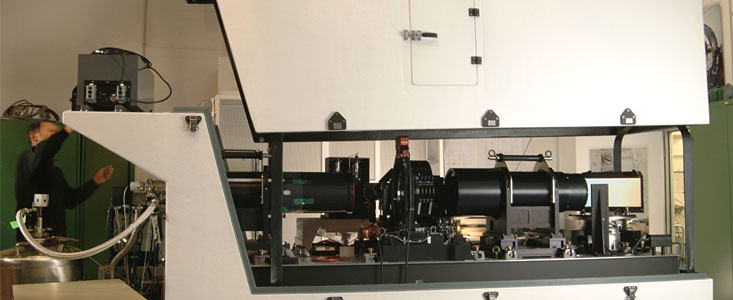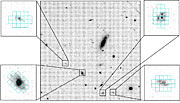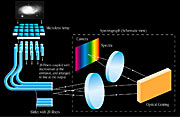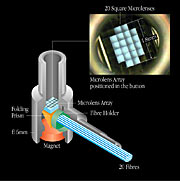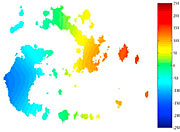Tisková zpráva
Multiple Eyes for the VLT
First System of Deployable Multi-Integral Field Units Ready
28. ledna 2002
The ESO Very Large Telescope (VLT) at the Paranal Observatory is being equipped with many state-of-the-art astronomical instruments that will allow observations in a large number of different modes and wavebands [1]. Soon to come is the Fibre Large Array Multi-Element Spectrograph (FLAMES) , a project co-ordinated by ESO. It incorporates several complex components, now being constructed at various research institutions in Europe and Australia.
One of these, a true technological feat, is a unique system of 15 deployable fibre bundles, the so-called Integral Field Units (IFUs) . They can be accurately positioned within a sky field-of-view measuring no less that 25 arcmin in diameter, i.e., almost as large as the full Moon . Each of the IFUs looks like an insect's eye and images a small sky area (3 x 2 arcsec 2 ) with a multiple microlens. From each IFU, 20 narrow light beams are sent via optical fibres to an advanced spectrograph. All 300 spectra are recorded simultaneously by a sensitive digital camera.
A major advantage of this technique is that, contrary usual spectroscopic observations in which spectral information is obtained along a (one-dimensional) line on the sky, it now allows (two-dimensional) area spectroscopy . This will permit extremely efficient spectral observations of many celestial objects, including faint galaxies, providing detailed information about their internal structure and motions. Such studies will have an important impact on our understanding, e.g., of the early evolution of galaxies , the main building blocks in the Universe.
The IFUs have been developed by a team of astronomers and engineers [2] at the Observatoire de Paris-Meudon. All IFU components are now at the ESO Headquarters in Garching (Germany) where they are being checked and integrated into the instrument [3].
The FLAMES instrument and its many parts
Late last year, the ESO Very Large Telescope (VLT) at the Paranal Observatory received its newest instrument, NAOS-CONICA . The first tests were very successful, cf. ESO Press Release eso0137.
But this is far from the last. Work is now underway at several European and overseas research institutes to complete the many other large astronomical instruments planned for the VLT. Over the next years, these new facilities will enter into operation one by one, further enhancing the capabilities of this true flagship of European science.
One of these instruments is the Fibre Large Array Multi-Element Spectrograph (FLAMES) , to be installed at the 8.2-m VLT KUEYEN Unit Telescope. It will be able to observe the spectra of a large number of individual, faint objects (or small sky areas) simultaneously and incorporates several highly complex components, e.g.,
- a Nasmyth Corrector - an optical system to focus the light that is received from the telescope over a sky field of no less than 25 arcmin in diameter, i.e., almost as large as the full Moon . It was installed on KUEYEN in September 2001
- a Fibre Positioner (known as "OzPoz"). It is now being built by the AUSTRALIS Consortium, lead by the Anglo Australian Observatory (AAO) , cf. ESO Press Release eso9824
- a high- and intermediate-resolution optical spectrograph, GIRAFFE , with its own fibre system, developed by the Observatoire de Paris-Meudon in close collaboration with ESO . It is now in the process of being assembled in the ESO laboratories in Garching, cf. ESO Press Photo eso0104a .
Work at the FLAMES facility will be supported by specialized data reduction software developed by Observatoire de Genève-Lausanne in collaboration withObservatoire de Paris-Meudon , and specialized observing software developed at ESO . There will also be a fibre link to the UVES high-dispersion spectrograph and there are plans for incorporating an intermediate resolution IR spectrograph in the future; the ITAL-FLAMES consortium is now preparing the associated instrument control and data reduction software packages.
The Integral Field Units (IFUs) for FLAMES
When it enters into operation later this year [3], GIRAFFE will become the most efficient instrument of its kind available at the world's large optical/infrared telescopes. It will be especially suited for the study of the dynamical properties of distant galaxies - their motion in space, as well as the internal motions of their stars and gas clouds. Indeed, observations of the velocity fields in a large variety of galaxies in the early Universe (when its age was only one third to one half of its current age) will be essential for a better understanding of those major building blocks of the Universe.
This is first of all due to the unique system of 15 deployable fibre bundles, the Integral Field Units (IFUs), that can be accurately positioned within a field-of-view measuring no less than 25 arcmin across, cf. ESO Press Photo eso0203 . Each IFU is a microscopic, state-of-the-art two-dimensional lens array with an aperture of 3 x 2 arcsec 2 on the sky. It contains twenty micro-lenses coupled with optical fibres leading the light recorded at each point in the field to the entry slit of the spectrograph, cf. ESO Press Photo eso0203 .
A great advantage of this technique is that, contrary to usual spectroscopic observations in which spectral information is obtained along a (one-dimensional) line on the sky, it now allows (two-dimensional) area spectroscopy . It is therefore possible to obtain spectra of larger areas of a celestial object simultaneously, and not just along one particular diameter.
With 15 IFUs at their disposal, the astronomers will be able to observe many galaxies at the same time - this will represent a tremendous gain of efficiency with many more astrophysical data collected within the available observation time!
The IFU design
ESO Press Photo eso0203 shows the mechanical design of the entrance of one IFU. An array of 20 square microlenses, each measuring 1.8 x 1.8 mm 2 is used to concentrate the light in the corresponding, small sky field onto a prism that passes the light on to 20 fibres. These are inserted and cemented into a mechanical holder and the entire assembly is then mounted in an IFU "button" that will be positioned in the focal plane by the OzPoz Positioner.
A magnet is incorporated at the base of the button to ensure a stable position (a firm hold) on the focal plate during the observation. The optical cementing is ensured with an UV curing and the fibre bundle is cemented into the button with an epoxy glue in order to ensure excellent stiffness of the complete assembly. The external diameter of the button is about 6 mm, corresponding to about 11 arcsec on the sky, allowing quite close positioning of the buttons on the focal plate.
An example of astronomical observations with IFUs
During the astronomical observation with the IFUs, the spectrograph slit receives light from 15 sky areas simultaneously, each with 21 fibres (20 from the IFU and 1 that collects the light from the night sky in an adjacent sky field) or 22 fibres (with the addition of 1 fibre with light from a calibration lamp). Altogether, about 300 spectra are recorded simultaneously.
By means of such observations, the astronomers can perform many different studies, e.g., of the dynamics of star clusters and motions of stars and interstellar clouds in galaxies.
ESO Press Photo eso0203 provides an example of a computer simulation of a resulting diagramme in which the internal rotation of a distant spiral galaxy is clearly visible. Red and yellow areas have positive velocities that are approaching while the blue areas are receding). Of special interest will be the study of the often violent motions when two or more galaxies interact gravitationally.
Poznámky
[1] This is a joint Press Release of ESO and the Observatoire de Paris (cf. http://www.obspm.fr/actual/nouvelle/jan02/flames.shtml).
[2] The GIRAFFE team at the Observatoire de Paris that has developed the Integral Field Units (IFUs) discussed in this Press Release includes Jean-Pierre Aoustin, Sebastien Baratchart, Patrice Barroso, Veronique Cayatte, Laurent Chemin, Florence Cornu, Jean Cretenet, Jean-Paul Danton, Hector Flores, Francoise Gex, Fabien Guillon, Isabelle Guinouard, Francois Hammer, Jacques Hammes, David Horville, Jean-Michel Huet, Laurent Jocou, Pierre Kerlirzin, Serge Lebourg, Hugo Lenoir, Claude Lesqueren, Regis Marichal, Michel Marteaud, Thierry Melse, Fabrice Peltier, Francois Rigaud, Frederic Sayede and Pascal Vola .
[3] It is expected to ship the various components of the FLAMES instrument to the VLT Observatory at Paranal (Chile) during the next month. "First Light" is scheduled to take place some weeks thereafter, following installation at the telescope and extensive system tests. ESO will issue another Press Release with more details on that occasion.
Kontakty
François Hammer
Observatoire de Paris-Meudon
Paris, France
Tel.: +33 1 45 07 74 08
Email: francois.hammer@obspm.fr
Gerardo Avila
ESO
Garching, Germany
Tel.: +4989-3200-6394
Email: gavila@eso.org
O zprávě
| Tiskové zpráva č.: | eso0203 |
| Legacy ID: | PR 01/02 |
| Jméno: | FLAMES, Instrumentation, Spectrum |
| Typ: | Unspecified : Technology : Observatory : Instrument |
| Facility: | Very Large Telescope |
| Instruments: | FLAMES |
Our use of Cookies
We use cookies that are essential for accessing our websites and using our services. We also use cookies to analyse, measure and improve our websites’ performance, to enable content sharing via social media and to display media content hosted on third-party platforms.
ESO Cookies Policy
The European Organisation for Astronomical Research in the Southern Hemisphere (ESO) is the pre-eminent intergovernmental science and technology organisation in astronomy. It carries out an ambitious programme focused on the design, construction and operation of powerful ground-based observing facilities for astronomy.
This Cookies Policy is intended to provide clarity by outlining the cookies used on the ESO public websites, their functions, the options you have for controlling them, and the ways you can contact us for additional details.
What are cookies?
Cookies are small pieces of data stored on your device by websites you visit. They serve various purposes, such as remembering login credentials and preferences and enhance your browsing experience.
Categories of cookies we use
Essential cookies (always active): These cookies are strictly necessary for the proper functioning of our website. Without these cookies, the website cannot operate correctly, and certain services, such as logging in or accessing secure areas, may not be available; because they are essential for the website’s operation, they cannot be disabled.
Functional Cookies: These cookies enhance your browsing experience by enabling additional features and personalization, such as remembering your preferences and settings. While not strictly necessary for the website to function, they improve usability and convenience; these cookies are only placed if you provide your consent.
Analytics cookies: These cookies collect information about how visitors interact with our website, such as which pages are visited most often and how users navigate the site. This data helps us improve website performance, optimize content, and enhance the user experience; these cookies are only placed if you provide your consent. We use the following analytics cookies.
Matomo Cookies:
This website uses Matomo (formerly Piwik), an open source software which enables the statistical analysis of website visits. Matomo uses cookies (text files) which are saved on your computer and which allow us to analyze how you use our website. The website user information generated by the cookies will only be saved on the servers of our IT Department. We use this information to analyze www.eso.org visits and to prepare reports on website activities. These data will not be disclosed to third parties.
On behalf of ESO, Matomo will use this information for the purpose of evaluating your use of the website, compiling reports on website activity and providing other services relating to website activity and internet usage.
Matomo cookies settings:
Additional Third-party cookies on ESO websites: some of our pages display content from external providers, e.g. YouTube.
Such third-party services are outside of ESO control and may, at any time, change their terms of service, use of cookies, etc.
YouTube: Some videos on the ESO website are embedded from ESO’s official YouTube channel. We have enabled YouTube’s privacy-enhanced mode, meaning that no cookies are set unless the user actively clicks on the video to play it. Additionally, in this mode, YouTube does not store any personally identifiable cookie data for embedded video playbacks. For more details, please refer to YouTube’s embedding videos information page.
Cookies can also be classified based on the following elements.
Regarding the domain, there are:
- First-party cookies, set by the website you are currently visiting. They are stored by the same domain that you are browsing and are used to enhance your experience on that site;
- Third-party cookies, set by a domain other than the one you are currently visiting.
As for their duration, cookies can be:
- Browser-session cookies, which are deleted when the user closes the browser;
- Stored cookies, which stay on the user's device for a predetermined period of time.
How to manage cookies
Cookie settings: You can modify your cookie choices for the ESO webpages at any time by clicking on the link Cookie settings at the bottom of any page.
In your browser: If you wish to delete cookies or instruct your browser to delete or block cookies by default, please visit the help pages of your browser:
Please be aware that if you delete or decline cookies, certain functionalities of our website may be not be available and your browsing experience may be affected.
You can set most browsers to prevent any cookies being placed on your device, but you may then have to manually adjust some preferences every time you visit a site/page. And some services and functionalities may not work properly at all (e.g. profile logging-in, shop check out).
Updates to the ESO Cookies Policy
The ESO Cookies Policy may be subject to future updates, which will be made available on this page.
Additional information
For any queries related to cookies, please contact: pdprATesoDOTorg.
As ESO public webpages are managed by our Department of Communication, your questions will be dealt with the support of the said Department.
